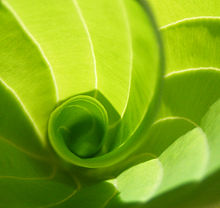- Vernation
-
Vernation (from vernal meaning spring, since that is when leaves spring forth in temperate regions) is the formation of new leaves or fronds. In plant anatomy, it is the arrangement of leaves in a bud.
In pine trees new leaves are short and encased in sheaths. Each leaf bundle consists of 2 to 5 needles. All the leaves on one section of branch grow in length together. In the cabbage, new leaves are folded over, each covered by the previous leaf.
Contents
Circinate vernation
Circinate vernation is the manner in which a fern frond emerges. As the fern frond is formed, it is tightly curled so that the tender growing tip of the frond (and each subdivision of the frond) is protected within a coil. At this stage it is called a crozier (after the shepherd's crook) or fiddlehead (after the scrollwork at the top of a violin). As the lower parts of the frond expand and toughen up, they begin to photosynthesize, supporting the further growth and expansion of the frond. In the case of many fronds long hairs or scales provide additional protection to the growing tips before they are fully uncoiled. Circinate vernation may also be observed in the extension of leaflets, in the compound leaves of Cycads.[1] Circinate vernation is also typical of the carnivorous plant family Droseraceae,[2] for example see this photo of Drosera filiformis.
Convolute vernation
The process of convolute vernation involves the wrapping of one margin of the leaf's blade over the other. This folding mechanism makes the emerging leaf look like a tube.
Involute vernation
In involute vernation both margins on opposing sides of the leaf are rolled up forming two tubes that meet at the midrib of the leaf.
See also
- Aestivation — the way in which the petals and sepals of a flower are arranged in a bud.
- Ptyxis — the way an individual leaf is folded within a bud.
References
- ^ [1]
- ^ Cameron, K. M.; Wurdack, K. J.; Jobson, R. W. (2002), "Molecular evidence for the common origin of snap-traps among carnivorous plants", American Journal of Botany 89 (9): 1503, doi:10.3732/ajb.89.9.1503
Categories:
Wikimedia Foundation. 2010.



